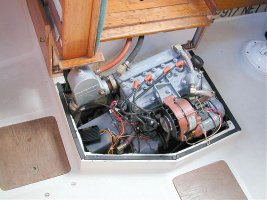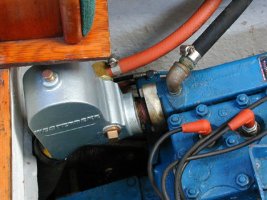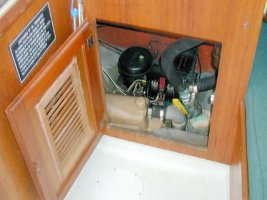jreddington
Member III
Posted the below on the Sailnet Ericson group. Got some good feedback, but the more the merrier. I'm still looking for sources for the bronze elbows, especially since one has to go in about a foot beyond the mixing elbow and the fiberglass elbows say you need to be at least two feet away.
Universal 5411 (11 hp) engine is out of the boat for some work. Cleaning up the engine compartment, replacing hoses, etc.
Removed the Vernalift muffler. Was a bit dismayed about the amount of junk I was able to flush and shake out of the muffler. And I think most of it felt like pieces out of the engine exhaust manifold and other internal parts. Putting on a new exhaust manifold and exhaust elbow anyway so I think I'm OK. Are there any "wear" parts internal to the muffler I should worry about and replace the muffler? Externally, it seems almost like new.
Replacing exhaust hosing. Noted that the engine has a bronze check valve between the exhaust elbow (water injection) and the muffler. Right now the flap is stuck open so it wasn't doing its "check" function anyway.
1st question. How critical is that check valve anyway? I've got to check again but I don't think there is an anti-siphon loop in the exhaust so this may be very important. However, if it's not needed I can eliminate it and some back pressure.
2nd question. Exhaust run between the exhaust elbow and the lift muffler has a 90 degree bronze elbow (plus the check valve) and one from the muffler to the main exhaust run. These will need replacing. What are folks' experience with the fiberglass elbows made by the same company as the Vernalift muffler (Centek)? Are there bronze equivalents? If so, I can't find a source for them. If I install a check valve should I also use the non-metallic one also made by Centek?
Looks like both West Marine and Defender have these Centek parts only as a special order. Any other sources for these components? (OK, that's a 3rd question (or 4th or 5th), enough for tonight.)
Universal 5411 (11 hp) engine is out of the boat for some work. Cleaning up the engine compartment, replacing hoses, etc.
Removed the Vernalift muffler. Was a bit dismayed about the amount of junk I was able to flush and shake out of the muffler. And I think most of it felt like pieces out of the engine exhaust manifold and other internal parts. Putting on a new exhaust manifold and exhaust elbow anyway so I think I'm OK. Are there any "wear" parts internal to the muffler I should worry about and replace the muffler? Externally, it seems almost like new.
Replacing exhaust hosing. Noted that the engine has a bronze check valve between the exhaust elbow (water injection) and the muffler. Right now the flap is stuck open so it wasn't doing its "check" function anyway.
1st question. How critical is that check valve anyway? I've got to check again but I don't think there is an anti-siphon loop in the exhaust so this may be very important. However, if it's not needed I can eliminate it and some back pressure.
2nd question. Exhaust run between the exhaust elbow and the lift muffler has a 90 degree bronze elbow (plus the check valve) and one from the muffler to the main exhaust run. These will need replacing. What are folks' experience with the fiberglass elbows made by the same company as the Vernalift muffler (Centek)? Are there bronze equivalents? If so, I can't find a source for them. If I install a check valve should I also use the non-metallic one also made by Centek?
Looks like both West Marine and Defender have these Centek parts only as a special order. Any other sources for these components? (OK, that's a 3rd question (or 4th or 5th), enough for tonight.)




